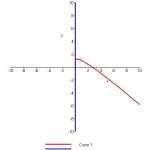f is the function defined over ]0,+infinity[ by \(\displaystyle f(x)=\frac{lnx}{\sqrt{x}}+1-x\)
Designate by (C) it's curve.
1) a) Determine Limit as x tends to 0 and deduce an asymptote (C).
Limit as x tends to 0 = -infinity . . . So x=0 is a verticle asymptote.
b) Determine limit as x tends to +infinity and show that the straight line (d) of equation y=-x+1 is an asymptote to (C).
Limit as x tends to +inf = -infinity . . .
Lim[f(x)-(-x+1)]=Lim[ln(x)/sqrt{x}] = o as x tends to +infinity so y=-x+1 is an asymptoe to (C).
c)Study the postiton of (C) with respect to (d) .
\sqrt(x) is positive for x belongs to ]0,+inf{.
lnx is positive for x >1 . . .So C above (d) for x>1
lnx is negative for 0<x<1 . . .So (C) below (d) for 0<x<1
lnx = 0 for x=1 . . . So (C) cuts (d) at x=1
d) Show that the derivative of f(x) has the same sign as \(\displaystyle g(x)=-(2x\sqrt{x}-2+lnx)\)
I found the derivative but It has no relation with g(x) . . .
e) Show that 1 is the only root of the equation g(x)=0 and deduce the sign of g(x).
Replace in g(x)=0 . . .
g(x)<0 for 0<x<1
g(x)>0 for x>1 ? ? ?
f) Study the variations of f and draw its table.
Since f'(x) follows g(x) so it has same sence as g(x).
g) Trace (C).
Thanks Again
Help please.
Designate by (C) it's curve.
1) a) Determine Limit as x tends to 0 and deduce an asymptote (C).
Limit as x tends to 0 = -infinity . . . So x=0 is a verticle asymptote.
b) Determine limit as x tends to +infinity and show that the straight line (d) of equation y=-x+1 is an asymptote to (C).
Limit as x tends to +inf = -infinity . . .
Lim[f(x)-(-x+1)]=Lim[ln(x)/sqrt{x}] = o as x tends to +infinity so y=-x+1 is an asymptoe to (C).
c)Study the postiton of (C) with respect to (d) .
\sqrt(x) is positive for x belongs to ]0,+inf{.
lnx is positive for x >1 . . .So C above (d) for x>1
lnx is negative for 0<x<1 . . .So (C) below (d) for 0<x<1
lnx = 0 for x=1 . . . So (C) cuts (d) at x=1
d) Show that the derivative of f(x) has the same sign as \(\displaystyle g(x)=-(2x\sqrt{x}-2+lnx)\)
I found the derivative but It has no relation with g(x) . . .
e) Show that 1 is the only root of the equation g(x)=0 and deduce the sign of g(x).
Replace in g(x)=0 . . .
g(x)<0 for 0<x<1
g(x)>0 for x>1 ? ? ?
f) Study the variations of f and draw its table.
Since f'(x) follows g(x) so it has same sence as g(x).
g) Trace (C).
Thanks Again
Help please.

